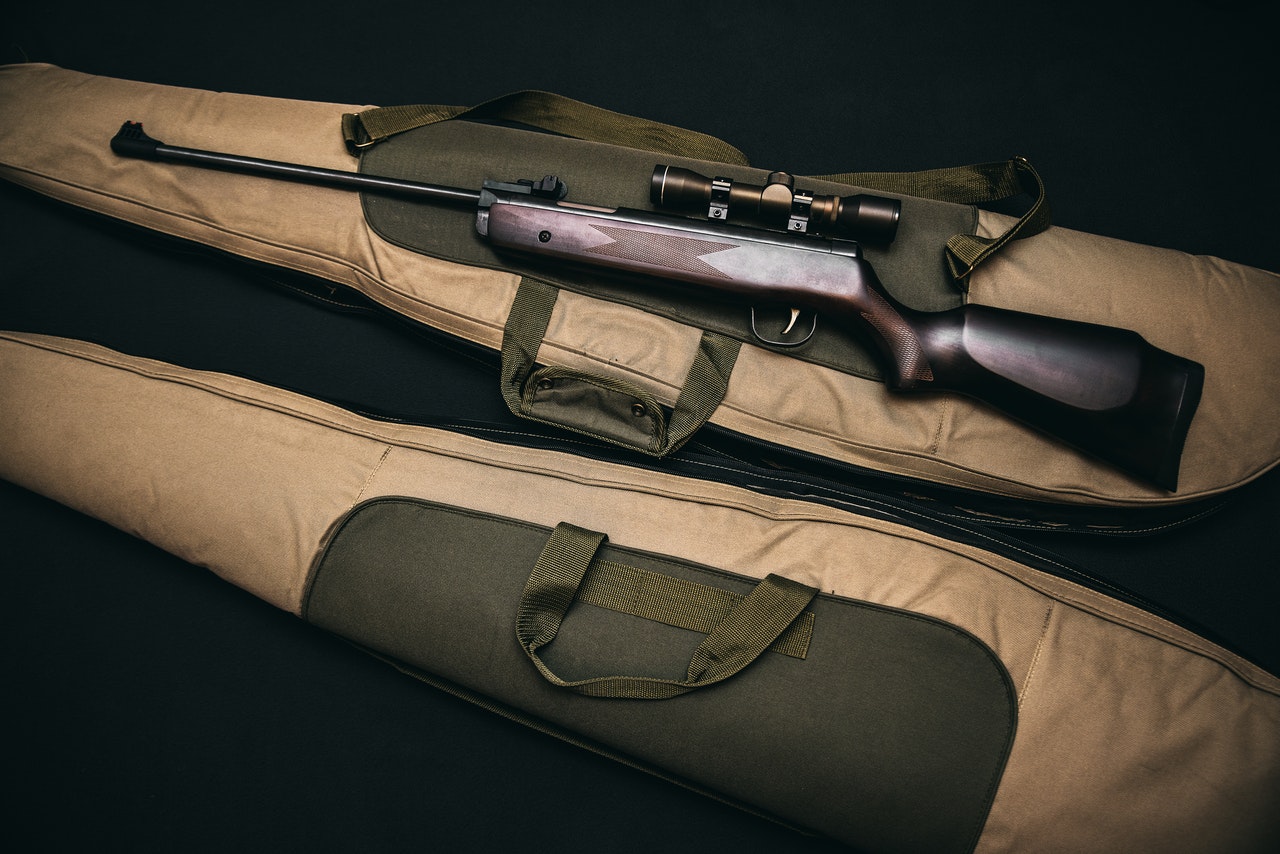
Beginner’s Guide to Gun Storage in 2024
More Americans are becoming gun owners than ever before. After all, this year needs no introduction. But whether you just bought your first handgun, shotgun, or long rifle, it’s incredibly important that every new owner first understand proper gun safety.
The most important factor in exercising proper gun safety when not shooting is good gun storage. Here’s how to best store your guns in the short- and long-term, including options for those “just-in-case” moments and daily carry.
Short-Term vs. Long-Term Storage
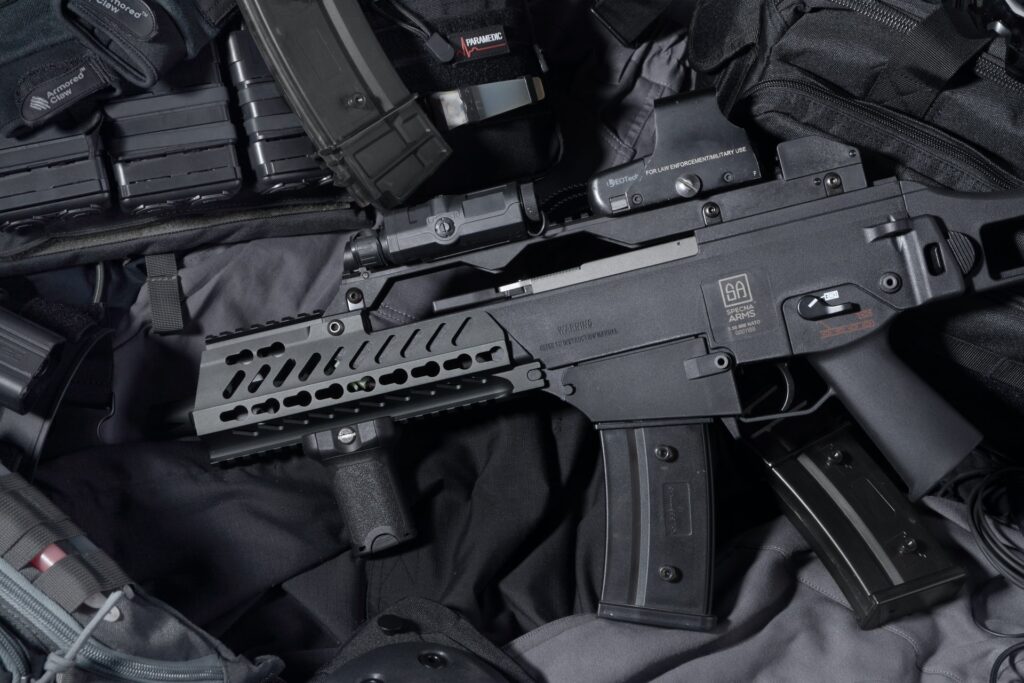
Firearms that are stored short-term are usually retrieved for daily use, hunting, or shooting. Short-term storage options also fall under the “self-defense planning” category. These options usually include portable lockboxes, travel safes, hard cases for long guns, and of course, your worn holster. Long-term storage is typically reserved for off-season hunting arms, and long guns and defense weapons not stored for daily carry or active planning. Think full-size gun safes, stationary lockboxes, and steel security cabinets.
Whether you’re looking for short- or long-term gun storage, your lockbox, safe, cabinet, or other storage option should satisfy the following conditions:
- Protection against theft or loss
- Easy access and accountability
- General reliability
Your gun storage needs to stop thieves, protect your guns from the elements, stop friends and children from gaining access, and afford you easy access when it counts. Most of all, your storage must be reliable. It’ll do you no good if your safe’s lock fails or your lockbox gets carried away in a burglary because it didn’t come with a bolt-down point or security cable. Let’s dive into the best storage. We’ll cover short- and long-term options for handguns and long guns.
Best Handgun Storage
1. Your Holster
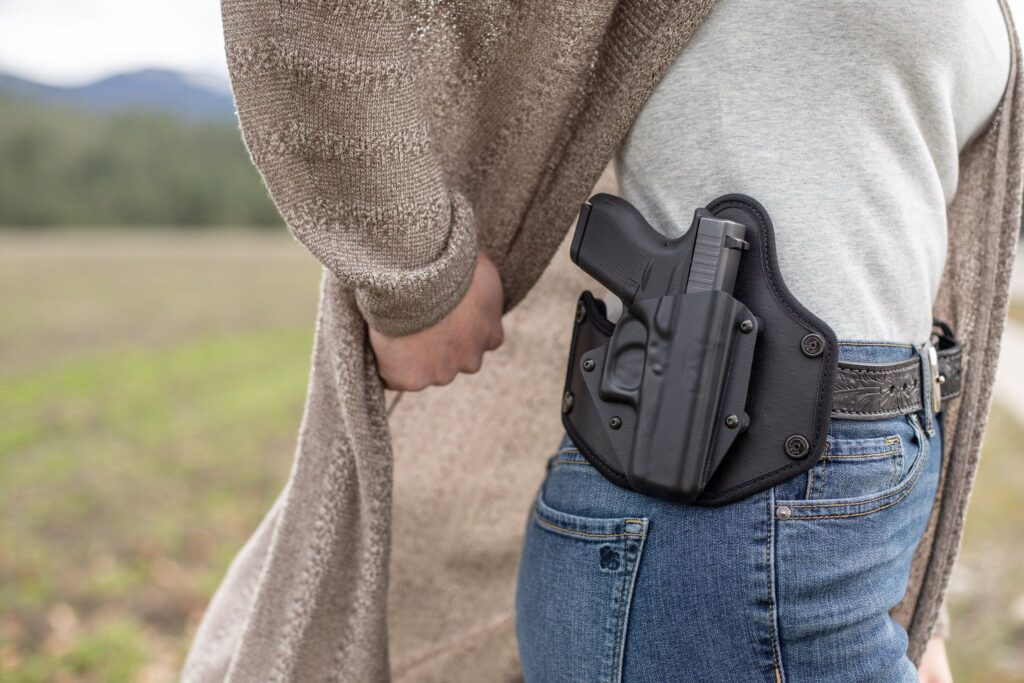
For the new gun owner, gun safety comes from accountability and control. There is no better way to learn control and carry of your firearm than simply wearing it as often as possible. While this may seem unconventional as a storage method, per se, it qualifies. IWBs, or inside-the-waistband holsters, can be worn discretely 24 hours, in just about any attire and environment.
Protection: Very High
Access: Very High
Reliability: Very High
Simply wearing your gun will also help to improve your marksmanship if you’re a new handgun owner. Practicing drawing and holstering your weapon (safely, with your weapon empty and always aimed in a safe direction) will translate into confidence at the range or while traveling and carrying.
2. Pistol Cases & Portable Lockboxes
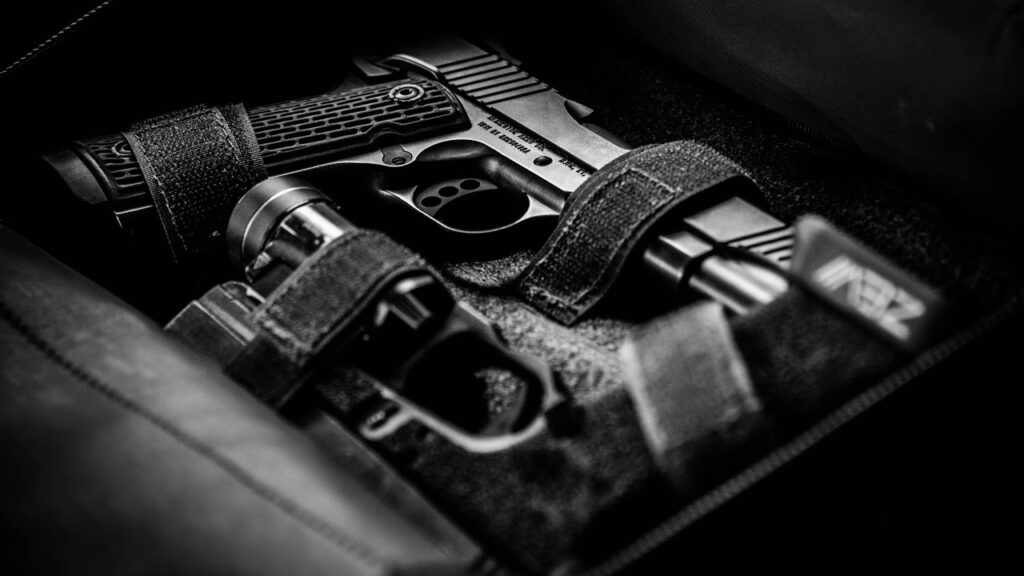
If you’re a new handgun owner, chances are you may not be interested in carrying your new piece around right away. That’s understandable, especially if you haven’t yet gone to the range. In that case, you still need a storage option for your pistol or revolver that provides adequate protection without sacrificing quick access for self-defense.
The gold standard for any handgun owner, whether for at-home storage or travel, is the pistol case or lockbox. Constructed from shatterproof high-test polymer or steel, these portable lockboxes are perfect for storing your handgun. These cases are perfect for keeping your handgun in the nightstand next to the bed, up high in the closet away from children, or in luggage for travel (many locking pistol cases are TSA-approved as checked baggage).
A Note About Pistol Case Locks
Small lockboxes all do the same thing: They use a hard shell and stronger hinges to provide a tough little container that protects your handgun. The big thing you should consider when buying any handgun case is the lock itself. To keep things simple, stick to a digital combination, fingerprint, or mechanical Simplex punch lock. These three types of locks are the most reliable and provide nearly instant access without the need to hold a key or fidget with a tumbler.
3. At-Home Fire Safe
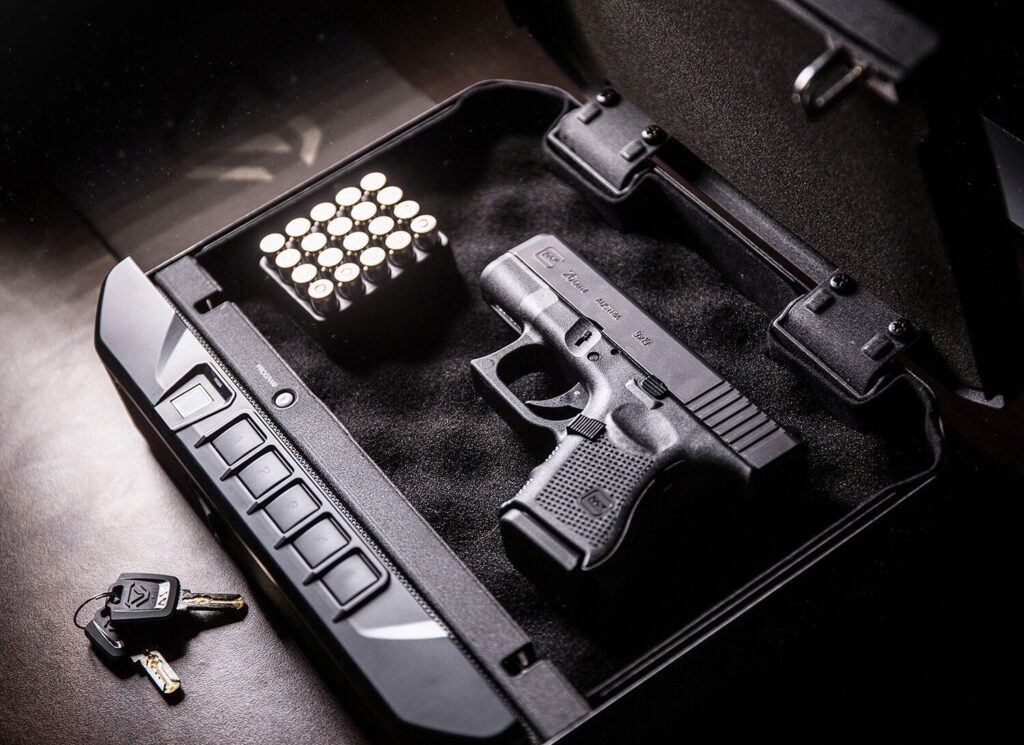
Whether you own a firearm or not, it’s typically a good idea to invest in some kind of protective container for personal and sensitive items in your home. Stationary fire safes and document-sized protective containers make perfect handgun safes. These small but stationary lockboxes can fit under a bed, in a closet, or in any small space. They can typically be bolted to wall or flood studs to prevent theft, and most come with some level of fire protection.
A Note About Safe Fire Protection
Not all fire safes are made equal. You should stick to options that advertise fire safety certifications from the Underwriters Laboratory, or the safe should come with documentation that explains how its fire rating was tested and achieved. Certified fire safes will display a “UL” rating explaining its fire protection. These same UL ratings are also found on full-size gun safes. More on those later.
How to Not Store Handguns
- First, never store any handgun unsecured. Even if you live alone, it only takes seconds for a determined burglar to gain access to a property if he or she is willing enough. Firearms should never be left unaccounted for this reason. Always store your handguns in a lockbox, safe, or locking security cabinet.
- Second, never leave your handguns stored anywhere you can’t reach them quickly. Unless you’re operating on a survivalist’s mentality and have a long-term storage method for arms and other equipment, leave your handguns nearby.
- Third, never leave a gun stored in a vehicle, even if the vehicle is locked or in a garage and the weapon inside is secured, too. Most firearms that are lost or stolen in the U.S. are taken from unoccupied vehicles.
- Lastly, never store your handguns in the master bedroom, office, or living room when not at home. These are the places burglars check most. Guest bedroom closets, a pantry shelf, or a small cabinet in any hallway are the places burglars are known to check the least.
Best Long Gun Storage
1. Hard Long Gun Cases
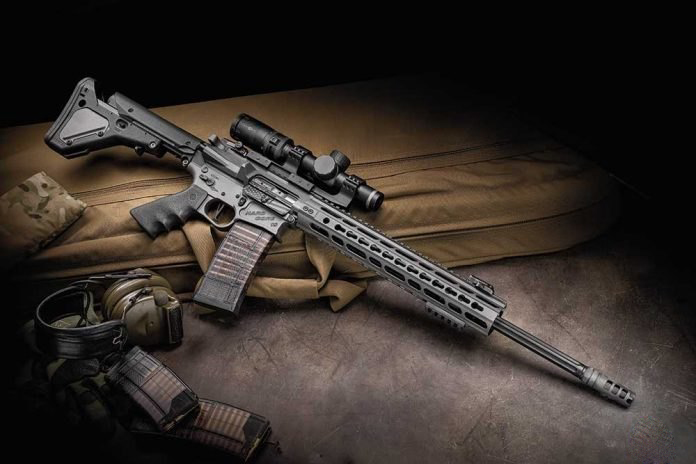
To accommodate long guns, cases made from polymer or soft ballistic nylon are available. It’d simply be impossible to store a long gun in a steel lockbox and expect it to be portable. A good polymer rifle case can withstand attack and attempted theft as well as a steel case can. Soft rifle cases are intended for transport. They’re also used as added protection inside a locked container. It is never advisable to store any long gun in an unsecured soft case because they provide no security. That means investing in a hard case, at minimum.
Unlike pistol cases, most hard long gun cases require the use of padlocks. Some high-end units come with built-in locks, too. But few to no rifle or shotgun cases are equipped with quick-access locks, like a fingerprint scanner. This can make gaining access to your guns take longer (especially in an emergency) so keep this in mind when shopping for short-term storage for your rifles and shotguns.
A Note About AR-15 Hard Cases
Most bolt-action rifles, shotguns, and long guns have relatively short magazines, low-profile sights, and thin stocks. This makes storage for most long guns straightforward. The AR-15 rifle, however, may have a hard time fitting in any old case. This is because the average AR-type rifle comes with a 30-round magazine, long pistol grip, and some sort of raised iron sights or optics.
If you own long guns, chances are high that you probably own an AR-15 or similar black rifle. If that’s the case, you need to shop around for a rifle case that is not only long enough, but wide enough. The minimum case width you should consider for an AR gun case is about 10”, with a minimum length of 36”. This will ensure the barrel, stock, receivers, grip, and any top-mounted sights fit length- and width-wise. The average AR 15 case will be labeled as such, with dimensions advertised. Examples can be found here.
2. Full-Size Gun Safe
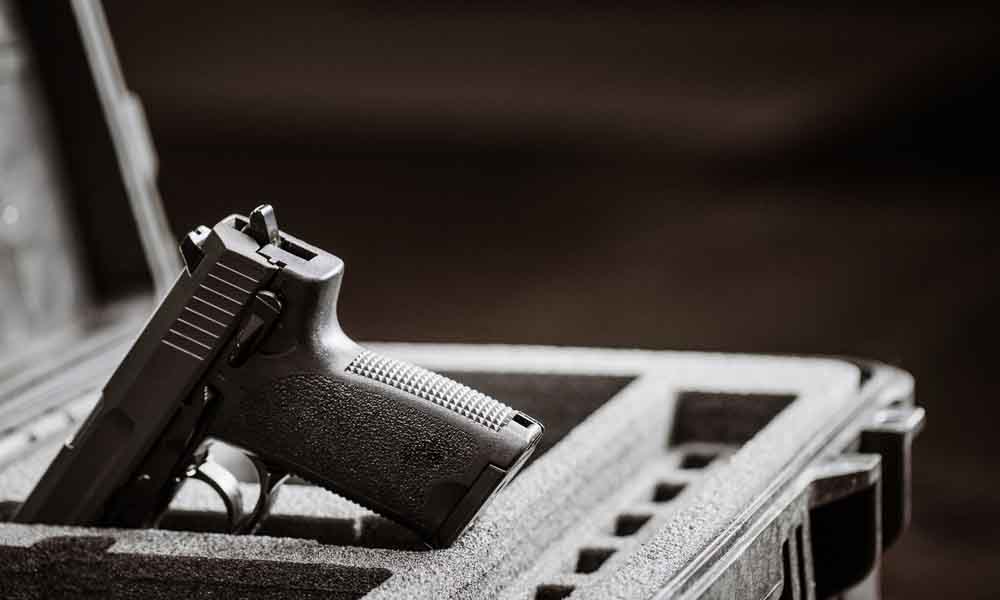
The top choice for gun storage among any gun owner, a fire- and attack-rated, full gun safe will withstand conventional bomb blasts, never mind a determined thief. The average safe weighs in at 300 pounds dry, with steel plating and insulating materials measuring at least 1” thick. Some safe’s doors can reach up to 12” thick. And for a safe that boasts respectable fireproof ratings, you can expect to spend at least $600 or more.
The tradeoff to accepting all this bulk, weight, and cost is a nearly undefeatable gun storage solution. A full gun safe is simply too big and heavy for any thief to carry away, and UL-rated safes can often withstand sustained attack with power tools and torches. Of course, this is an extreme solution for first-time gun owners.
A Note About Gun Safes
Gun safes require freight delivery and handling, and logistics and real planning must go into your purchase and installation. Whenever shopping for a full gun safe, always double-check the measurements in your home. That means not just confirming the space or closet where your safe will go, but all entryways stairs, and floors your delivery team will need to cover. Safes are not assembled on-site and some homes’ floors may not be rated to handle the weight, so check your building plans when ordering, too.
3. Locking Security Cabinet

The perfect (and arguably more popular) alternative to a full gun safe is the locking security cabinet made for long gun storage in the home. These gun cabinets are made from steel, like a gun safe. They do not, however, arrive as welded one-piece units. They also do not require massive insulating doors and panels because most don’t advertise fire protection. That means you can get an easy-to-assemble gun box that’ll fit in a space where most full-size safes simply can’t fit.
Security cabinets come with locks and protection features most like that of a fire safe or heavy-duty lockbox. They can be found with digital or mechanical combo locks, or simple key locks.
A Note About Security Cabinets
Not all security cabinets are adequate; some similarly priced or configured options may not come with critically important safety features. Whichever cabinet you pick, be sure it comes with the following features:
- Recessed (pry-resistant) hinges
- Backup mechanical entry (if digital)
- Bolt-down wall or floor anchor points
- Gun Storage Do’s and Don’ts
Now we’ve covered the best storage options for your handguns and long guns. It’s time to dive into a quick review of the most common mistakes new gun owners make, and what best practices you should instead employ.
Cold, dark, and dry. If you are storing your firearms long-term, these three conditions should be met above all else: Keep your guns in a dry location free of moisture and humidity. Keep guns away from direct sunlight or any windows (they should be in containers anyway). Pick a location that doesn’t see wild temperature changes throughout the year. A spare bedroom closet or the basement are top choices. Avoid attics and high-traffic areas.
With ammo separate. Never keep live ammo stored with a firearm if it isn’t your daily-carry handgun or self-defense weapon. If a child or burglar ever got access to a gun in your home, you would not want them to have immediate access to the ammo, too.
With desiccant packets. Even if you invest in a high-quality gun safe or cabinet and pick a good storage location for your firearms, you should put one or two desiccant silica gel packets inside your gun’s storage unit. These silica packets absorb moisture that can’t be seen, preventing rust and corrosion from pitting the surfaces of your firearms over time. These packets can be heated, dried, and reused as needed or every 3 to 6 months. Visit for more information on 80 lowers.
